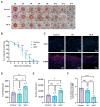Photo-Crosslinked Pro-Angiogenic Hydrogel Dressing for Wound Healing
- PMID: 39337435
- PMCID: PMC11432402
- DOI: 10.3390/ijms25189948
Photo-Crosslinked Pro-Angiogenic Hydrogel Dressing for Wound Healing
Abstract
Severe burns are one of the most devastating injuries, in which sustained inflammation and ischemia often delay the healing process. Pro-angiogenic growth factors such as vascular endothelial growth factor (VEGF) have been widely studied for promoting wound healing. However, the short half-life and instability of VEGF limit its clinical applications. In this study, we develop a photo-crosslinked hydrogel wound dressing from methacrylate hyaluronic acid (MeHA) bonded with a pro-angiogenic prominin-1-binding peptide (PR1P). The materials were extruded in wound bed and in situ formed a wound dressing via exposure to short-time ultraviolet radiation. The study shows that the PR1P-bonded hydrogel significantly improves VEGF recruitment, tubular formation, and cell migration in vitro. Swelling, Scanning Electron Microscope, and mechanical tests indicate the peptide does not affect the overall mechanical and physical properties of the hydrogels. For in vivo studies, the PR1P-bonded hydrogel dressing enhances neovascularization and accelerates wound closure in both deep second-degree burn and full-thickness excisional wound models. The Western blot assay shows such benefits can be related to the activation of the VEGF-Akt signaling pathway. These results suggest this photo-crosslinked hydrogel dressing efficiently promotes VEGF recruitment and angiogenesis in skin regeneration, indicating its potential for clinical applications in wound healing.
Keywords: burn; hydrogel; methacrylate hyaluronic acid; prominin-1-binding peptide; vascular endothelial growth factor; wound healing.
Conflict of interest statement
The authors declare no conflicts of interest.
Figures







Similar articles
-
In situ formed anti-inflammatory hydrogel loading plasmid DNA encoding VEGF for burn wound healing.Acta Biomater. 2019 Dec;100:191-201. doi: 10.1016/j.actbio.2019.10.004. Epub 2019 Oct 4. Acta Biomater. 2019. PMID: 31586729
-
Multifunctional protein-polysaccharide hydrogel with antimicrobial and angiogenic properties to promote infected wound healing.Biomater Adv. 2025 Dec;177:214387. doi: 10.1016/j.bioadv.2025.214387. Epub 2025 Jun 13. Biomater Adv. 2025. PMID: 40527064
-
In situ photo-crosslinkable hyaluronic acid-based hydrogel embedded with GHK peptide nanofibers for bioactive wound healing.Acta Biomater. 2023 Dec;172:159-174. doi: 10.1016/j.actbio.2023.10.011. Epub 2023 Oct 11. Acta Biomater. 2023. PMID: 37832839
-
Advancing burn wound treatment: exploring hydrogel as a transdermal drug delivery system.Drug Deliv. 2024 Dec;31(1):2300945. doi: 10.1080/10717544.2023.2300945. Epub 2024 Feb 16. Drug Deliv. 2024. PMID: 38366562 Free PMC article. Review.
-
Design Strategies and Application Potential of Multifunctional Hydrogels for Promoting Angiogenesis.Int J Nanomedicine. 2024 Nov 27;19:12719-12742. doi: 10.2147/IJN.S495971. eCollection 2024. Int J Nanomedicine. 2024. PMID: 39624117 Free PMC article. Review.
Cited by
-
Insights into Liposomal and Gel-Based Formulations for Dermatological Treatments.Gels. 2025 Mar 26;11(4):245. doi: 10.3390/gels11040245. Gels. 2025. PMID: 40277680 Free PMC article. Review.
-
Getting Blood out of a Stone: Vascularization via Spheroids and Organoids in 3D Bioprinting.Cells. 2025 May 1;14(9):665. doi: 10.3390/cells14090665. Cells. 2025. PMID: 40358189 Free PMC article. Review.
References
MeSH terms
Substances
Grants and funding
LinkOut - more resources
Full Text Sources
Research Materials

